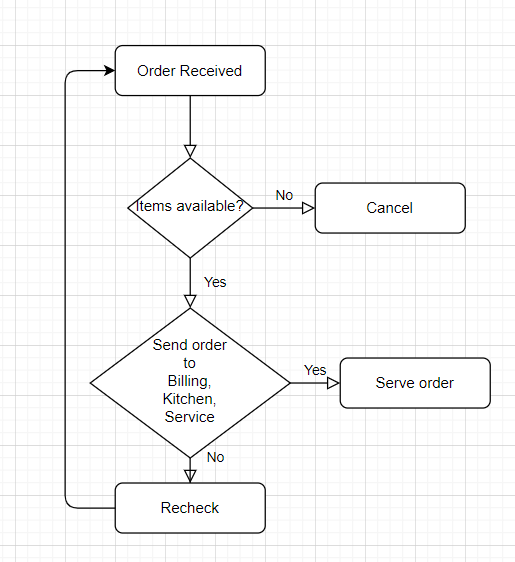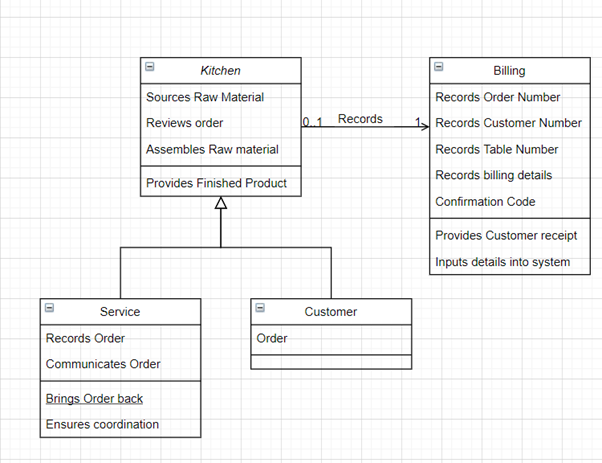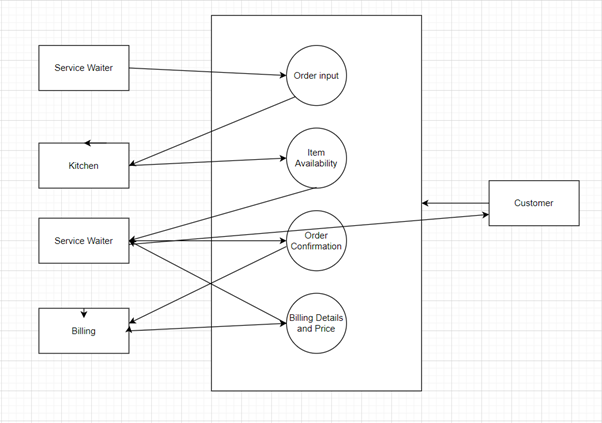Information System Assignment: Implementation Of IS By Cafe In Singapore
Question
Task:
Information System Assignment Task: You are the System Analyst involved in studying the creation & implementation of a new information system for an organization. Choose one of the following organizations.
- A Cafe in Singapore
- A Tuition centre which conducts lessons
- A minimart in Singapore
- Food Court/ Food Delivery in Singapore
- Fitness Centre in Singapore
Conduct library / Internet research on the typical operations of your chosen organization and use the information gathered to write a report. Your report must answer the following questions / sections and include all factors stated below.
- Provide an introduction to the organization that is relevant to rest of the answers. Suggestion: type of business, core concern, stakeholders.
- State the main business goal of the new IS. Provide a brief explanation.
- Draw a flowchart of the main business process that is to be automated. Provide a brief explanation of the flowchart.
- Identify the classes and give a 1-line description for each class (Write the answer in a table). Draw a simple (domain) class diagram which shows the name, attributes, relationship (including the multiplicity)
- Compare the choices in systems acquisition for this organization.
- Identify 3 objectives for this project (using SMART method). Justify your choices.
- Prepare a brief feasibility study report for the proposed system.
- Write a brief statement of requirements (about 1 page long) for this information system. Your answer must include different types of requirements (eg functional and non-functional).
- Draw a use case diagram for this system.
- Develop a conceptual model for the proposed information system. The conceptual model consists of the following:
- Storyboard
- Hardware, software and network components (just a list).
Importance must be placed on how the PISDM principles are cleared outlined and how they are applied in context to the issue.
Answer
Introduction
The organization which has been chosen herein information system assignment for the implementation of systems is a cafe in Singapore. In relevance to the type of business, it can be viewed that this business is a product and service-based business in the Food and Beverages industry which is a subset of the hospitality sector in itself. Mmutle et al. (2017), states that for hospitality business importance is mainly given to the service which surrounds the products and the experience for the customer. The core concern of the chosen business is to reduce the order time per client in real-time and not on bulk orders. Thus, the major stakeholders in this context would be the employees who work in the cafe, the management, the cooks and kitchen staff, and finally, the customers.
This study seeks to understand the implementation of an Information system that can ensure that the order and delivery system of food can be speed up for the Cafe in Singapore to accommodate lower wait times and increase customer acquisition through cutting down on time. A set of class diagrams, flowcharts, use case diagrams, and conceptual models will be used to understand the IS system. Specific goals and targets will also be set to ensure the proper strategic direction for the system.
The business goal of new Information System
The new IS system will streamline the order process and the overall management of the factors which are present in the supply chain to reduce the time delay of service. The main goal of the IS system will be to integrate the ordering framework and toad the lead time of decision making to cut down on step base time delays to impact the overall time duration of order delivery to the customers.
The primary goal of the system will be to automate processes starting from the point of order by the customer to the waiter and then the multiplicity of the same ought to be drawn out through the element of reducing time delays by communicating the order immediately to the kitchen removing processes from in between. Simultaneous communication to the billing department is also expected. The system will generate a time cut through engagement in quick information transfer with customer details and also will work on assigning service partners to the orders immediately to reduce system time lags.
Flowchart of Automated business process

Figure 1: Flowchart
(Source: Author)
The above flow chart provides a clear indication of the systems which need to be upgraded using the automation process. It can be viewed that the first and most primary stage is that of the order receipt. Upon this either the order is confirmed or not. Additionally, it can be viewed that the confirmation leads to the communication continuing to the kitchen, billing, and service departments. Under this circumstance either the order is served, or due to delays and issues, the order is rechecked. This gives a clear idea of the processes which are involved in the case of the ordering system at the Cafe.
Identification of classes and Domain Class Diagram
|
Class |
Description |
|
Customers |
This class indicates the customers who have arrived at the Cafe, the main stakeholders, and the starting point of the order system. |
|
Service |
This class is defined by the service staff who take and relay the orders and bring the finished products back to the customers. |
|
Kitchen |
This class is the class that plays a role in the preparation of the finished goods through the means of assembling the raw materials. |
|
Billing |
This class defines the accounts of the ordering system and the documentation aspect of this system. |

Figure 2: Simple Class Diagram
(Source: Author)
Comparison of Choices in systems available
In the case of the overall systems which are available, it can be viewed that these are called Point of Order Systems. Leung (2019), indicates that a POS system aids in the ordering structure and framework of an organization. The options available for the Cafe in Singapore due to high competition include Touch-Bistro which allows excellent inventory management, payment processing options, and a very simple and sleek interface. The pricing of this system is kept at $ 69 a month on average. This allows for a very competitive price to be achieved and maintained.
Contrary to this, Toast is a system that aims specifically at the aspect of mobile ordering. It can be viewed that this is more in line with the business goals of time reduction which are sought to be achieved through the implementation of IS. Additionally, this also provides options and aids customer service which plays to the advantage of the Cafe in Singapore, and additionally, the robust reporting system also falls in line with the necessary levels of impact which need to be ensured. This system costs $79 a month, but is more in line with the organizational IS goals.
Objectives for project
Objective 1: To reduce the time delay in ordering and serving the order to the customer.
|
Specific |
The goal is specific as it seeks to reduce time delay in tangible processes. |
|
Measurable |
The goal is measurable through the amount of time reduced. |
|
Achievable |
The goal is achievable by the implementation of the IS system. |
|
Realistic |
It is realistic as it can be achieved and is tangible. |
|
Time-bound |
It can be achieved within a month. |
Objective 2: To enhance customer satisfaction and service
|
Specific |
The goal is specific as it seeks to increase customer satisfaction in tangible processes. |
|
Measurable |
The goal is measurable through customer feedback. |
|
Achievable |
The goal is achievable by the implementation of the IS system. |
|
Realistic |
It is realistic as it can be achieved and is tangible. |
|
Time-bound |
It can be achieved within a month. |
Objective 3: Ensuring active and proper reporting
|
Specific |
The goal is specific as it seeks to ensure reporting in the organization. |
|
Measurable |
The goal is measurable through the means of proper documentation which is compliant. |
|
Achievable |
The goal is achievable by the implementation of the IS system. |
|
Realistic |
It is realistic as it can be achieved and is tangible. |
|
Time-bound |
It can be achieved within a month. |
Feasibility Study
Background
The cafe in Singapore is seeking to reduce the overall time delay in the ordering and customer service system which is available. This is being done to gain competitive advantages in the case of the highly competitive F&B market in the Singapore market. The Cafe needs to implement an IS system which will help in reducing customer order to order serving time. Ivanov (2019), indicates that automation of systems helps for better speed of service delivery.
Outline
The IS system which is required needs to specifically reduce time delays through an automated system of simultaneous communication with multiple departments in the cafe. These involved departments are service, billing, and the kitchen departments. Ramphal (2017), has indicated through their study that good IS systems provide integrated information flow and proper decision making. Thus, the major IS system requirement, in this case, is of ensuring that reporting at every stage of information flow is accurate and fast
Analysis
Analyzing the alternatives of the different IS systems available and the overall requirement it can be pinpointed that the major change for reduction of time delay needs to be brought in the management of the delay between customer order taking and communication to other departments. Thus, the IS system is to be set up to facilitate immediate information transfer to the kitchen and the billing departments. The kitchen in this case plays the composite role of the production and inventory departments.
Conclusion
Concluding from this feasibility analysis it is drawn out that the IS system aimed at customer service and reporting is an essential example of a proper IS system. This can be used for reducing the time delay of the system effectively This helps for ensuring a larger element of efficiency which can be brought around to the ordering framework for simultaneous communication.
Recommendation
Recommendations according to this indicate and imply the need for better and faster communication. Better reporting is also facilitated through such IS implementations, as this would ensure a larger impact on time delay reduction.
Statement of Requirements
Functional Requirements
The Functional requirements for the IS system which is to be incorporated circles around the concept of the product features which are to be ensured. It can be viewed that the primary features delineated for this IS system are:
- Smooth processing speed
- Real-time data communication
- Speedy relay of information to and fro from the case of the stakeholders
- Easy user interface for the users to use
- Ensuring that there is a larger rate of reporting through each stage of the functionality
In addition to this, the user requirements are important to be understood for the system as well. The key user requirements of the system are:
- Good user interface
- Quick user earning is facilitated by the system
- Shows the important KPI and data for decision making quickly
- Ensures real-time data changes and updates
- Accommodates all the required data for the required personnel
- Streamlines usage process
It is determinative from this that the system employed needs to be functionally lean in nature. Núñez-Merino et al. (2020), has stated that lean IS systems provide quick delivery of information and facilitate speedy processes.
Non-Functional Requirements
The non-functional requirements of a system include the product properties which are present in the inbuilt system altogether. This helps for the generation of a sound system that can generate impactful delivery of service. The product requirements are:
- Windows operating system, preferably 10
- Pentium 4 or Mac processor, any x86 processor or higher
- A minimum of 4 to 8 GB of RAM
- Storage space on the hard disk of at least 1 GB
- USB version 2.0 or better ports
- Stable broadband connection
- Any tablet with a proper processing capacity
In terms of user expectations the main areas to note are:
- Smooth user experience
- Quick relay of information and feedback
- Real-time information updates for better decision-making at point instances
- Easy options for addition and removal of order items from customer order with price updates and reporting ease
Thus, the information system needs to be extremely tuned and needs to be able to provide simultaneous channels of communication between all the different parties involved. This will help to reduce overall time lags which may be present.
Use case diagram

Figure 3: Use Case Diagram
(Source: Author)
The use case diagram indicates the element of the correlations which are present in the case of the system. It shows how the order is relayed through the system after being taken from the customer to the different departments. It can be noted that the interactions of the departments with the IS system facilitate the removal of system loops. Constable et al. (2019), indicates that system loops overburden a singular stakeholder. In the case of this, this is effectively avoided. It can be viewed from this, that this helps to smoothen the process out.
Conceptual Model
Storyboard
The storyboard in this case will be providing an element of the conceptual framework through the means of revealing the use case instructions which need to be undertaken. These will be defined in steps as followed:
- The customer places the order
- The service waiter inputs the same into their tablet and then there are relays the information to the kitchen
- Inventory check is conducted in the kitchen
- Service waiter confirms the availability of customer orders
- Order is placed by the service waiter upon animation
- Is communicates confirmation and the kitchen prepares the order while the billing department also gets confirmation
- The billing department prepares invoices and confirms the order details such as order number, table number, customer number and records the same.
- The service waiter waits till the order is prepared and serves the same with the invoice for the customer.
Hardware, Software, and Network Components
Hardware:
- Computers
- Tablets
- Screens and monitors
- Routers
- LAN or Optical Fibre
Software:
- Proper operating system
- UX/UI made for POS systems
- Smooth and friendly interface that facilitates learning
Network:
- Databases for data storage
- Internet and broadband connection
- Local Wi-Fi connection
Reference List
Constable, D. J., Jiménez-González, C., & Matlin, S. A. (2019). Navigating complexity using systems thinking in chemistry, with implications for chemistry education. Journal of Chemical Education, 96(12), 2689-2699.Retrieved on 4 May, from:https://pubs.acs.org/doi/pdf/10.1021/acs.jchemed.9b00368
Ivanov, S. (2019). Ultimate transformation: how will automation technologies disrupt the travel, tourism and hospitality industries?. ZeitschriftfürTourismuswissenschaft, 11(1), 25-43. Retrieved on 4 May, from:https://www.researchgate.net/profile/Stanislav-Ivanov-7/publication/331152771_Ultimate_transformation_How_will_automation_technologies_disrupt_the_ travel_tourism_and_hospitality_industries/links/5c6822d1299bf1e3a5ad2d99/Ultimate- transformation-How-will-automation-technologies-disrupt-the-travel-tourism-and-hospitality-industries.pdf
Leung, R. (2019). Smart hospitality: Taiwan hotel stakeholder perspectives. Tourism Review. Retrieved on 3 May, from:https://www.researchgate.net/profile/Rosanna_Leung/publication/326068211_Smart_hospitality_ Taiwan_hotel_stakeholder_perspectives/links/5da9c51ca6fdccc99d9146b2/Smart-hospitality- Taiwan-hotel-stakeholder-perspectives.pdf
Mmutle, T. (2017).Customers' perception of service quality and its impact on reputation in the hospitality industry. Information system assignment Retrieved on 3 May, from: https://repository.nwu.ac.za/bitstream/handle/10394/27781/2017Customers_perception.pdf?sequence=1
Núñez-Merino, M., Maqueira-Marín, J. M., Moyano-Fuentes, J., &Martínez-Jurado, P. J. (2020). Information and digital technologies of Industry 4.0 and Lean supply chain management: a systematic literature review. International Journal of Production Research, 58(16), 5034-5061. Retrieved on 4 May, from:https://zaguan.unizar.es/record/101540/files/texto_completo.pdf
Ramphal, R. R. (2017). Lean six sigma framework for the hospitality industry. Afr. J. Hospitality, Tourism Leisure, 6, 1-15. Retrieved on 4 May, from:http://www.ajhtl.com/uploads/7/1/6/3/7163688/article_47_vol_6__4__2017.pdf












